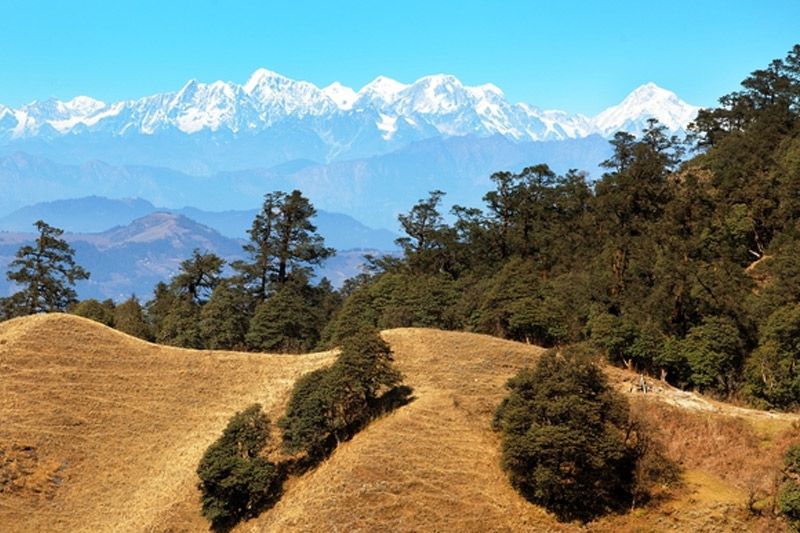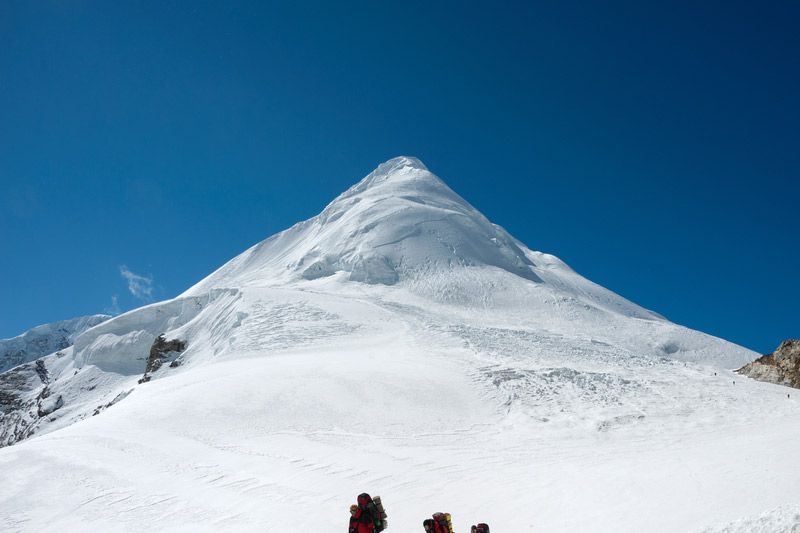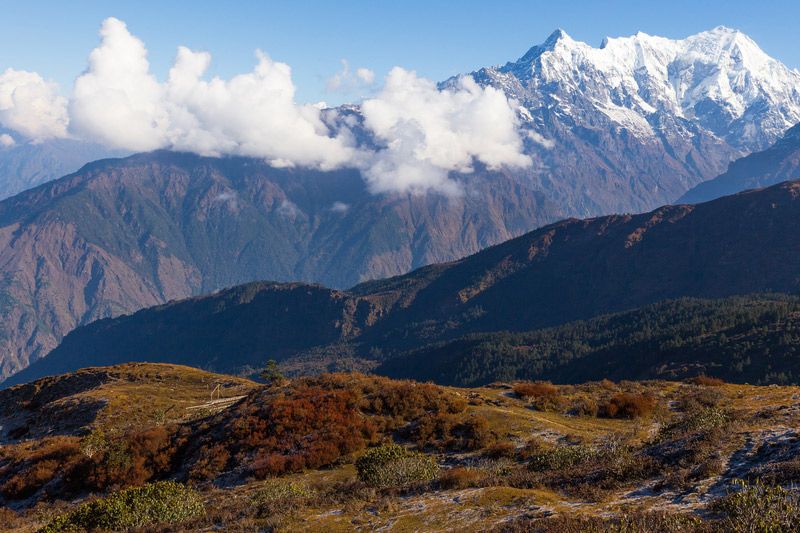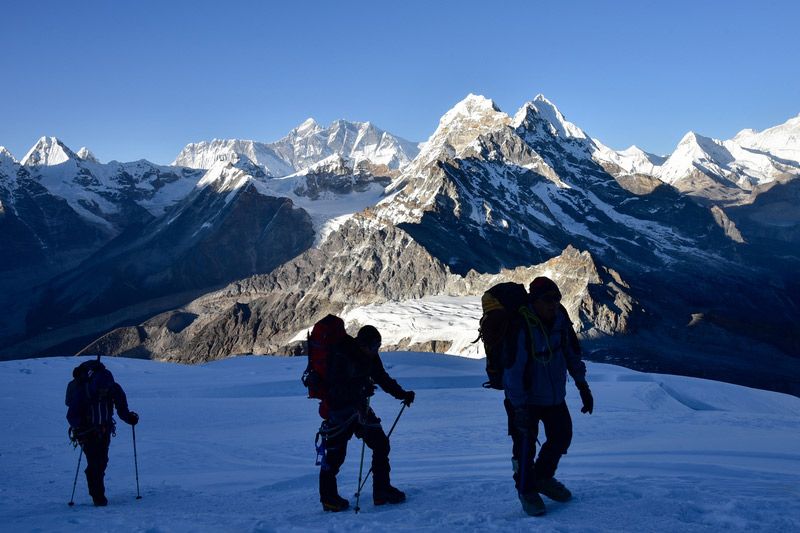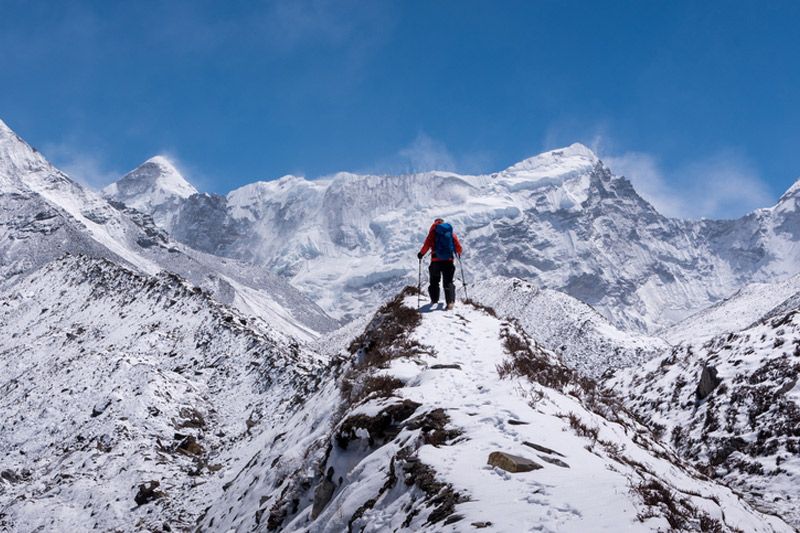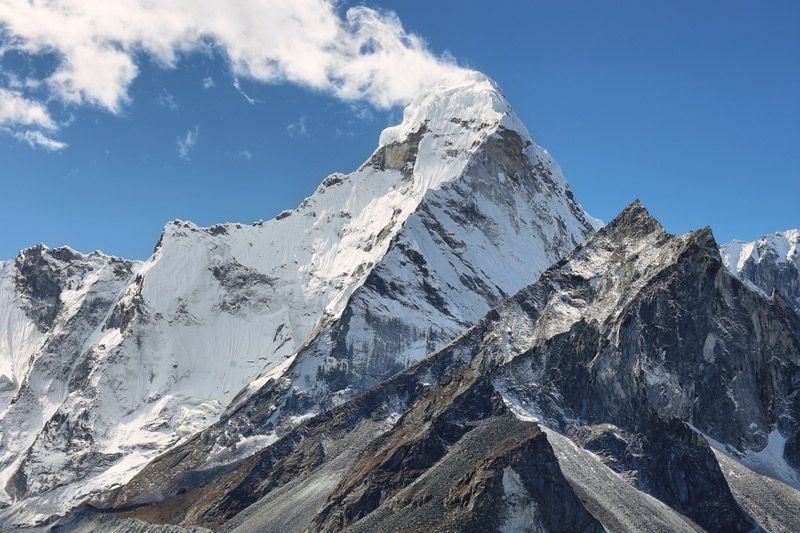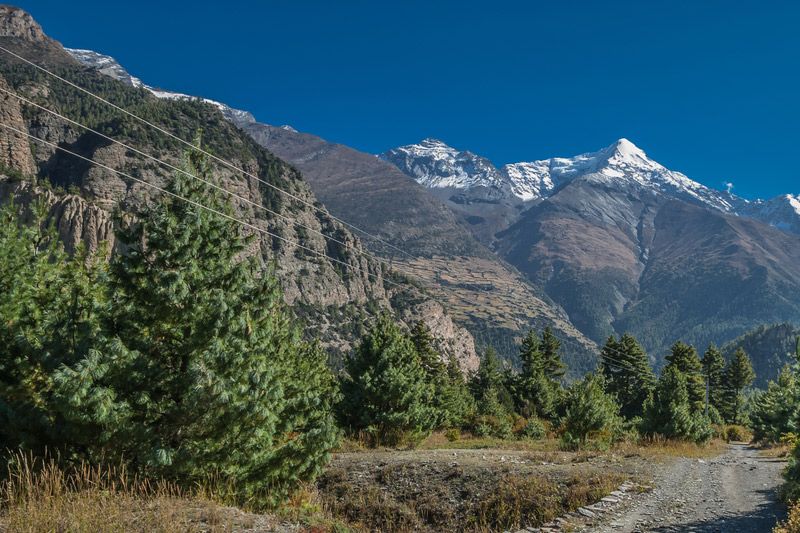Amphu Labtsa Pass Peak Climbing
Trip Overview of Amphu Labtsa Pass Peak Climbing
Mera peak(6,476m/21,246ft) and Island Peak (6,189m/20,305ft) are both highly sought after summits in their own right. Although geographically fairly close together, they are separated by the formidable mountain chain dividing the Hongu and Khumbu Valleys. This expedition provides a rare opportunity for climbers to attempt both peaks, linking them with a crossing of the difficult, yet stunning Amphu Labtsa Pass (5,780m/18,963ft). This has proved to be a very popular expedition as it provides a unique opportunity to visit one of the most beautiful and remote valleys in Nepal combined with a high altitude climbing programme, which takes participants through a progressive range of mountaineering skills. To give potential team members greater flexibility in planning their annual leave, we have departures in the spring (pre-monsoon) and in the autumn (post-monsoon).
We have extended this expedition by one day to a total of 30 days. This gives the leader flexibility in running the expedition and allows a greater margin for the vagaries of the weather and individual acclimatisation. It also provides time for a rest after crossing the Amphu Labtsa, so that batteries can be re-charged before Island Peak is attempted.
Detail itinerary of Amphu Labtsa Pass Peak Climbing
-
DAY 1-2
Arrive Kathmandu
We will be taken to the Summit Hotel, a delightful garden hotel situated away from the bustle of the city centre. It is possible to hire bicycles here, which enable the shops and bazaars of the city centre to be reached in 10 minutes or so.
-
DAY 3
Fly to Lukla
We will be taken to the airport for one of the great flights of the Himalaya. If the sky is clear during our flight, we will get our first views of Everest and the region in which we will be climbing. The Twin Otter aircraft will take us to the hillside village of Lukla, which is the start of our trek to Mera. Here we will meet our camp staff and porters and set off straight away for our first camp at Poyan (2,800m).
-
DAY 4
Pangkongma (2,846m)
After crossing the Poyan Khola, we turn off the main trade route coming up from the south and join an older route, which climbs steeply to the ridge-line overlooking the Khare Khola. Descending the other side of the ridge, we then contour along the hillside before climbing steadily up to the attractive farming and trading village of Pangkongma (2,846m). Many expedition members have been made welcome by the villagers here, spending several pleasant hours warming themselves in front of an open fire in the enveloping and welcoming atmosphere of the local's traditional Sherpa homes.
-
DAY 5
Nashing Dingma (2,600m)
With fine views westwards towards Takshindu monastery and Lamjura, we climb through thick rhododendron forest and bamboo leading to the Pangkongma La. From here, we have good views of the south face of Mera with its twin peaks and of its neighbour Naulekh. We then make a scenic descent with beautiful views looking south across the endless foothills rising each side of the Hinku valley. This steep descent leads down to the wire rope bridge that spans the Hinku Khola. A steep, strenuous climb on the opposite side leads to Nashing Dingma (2,600m). We stay here for the night at the excellent campsite established by the Makalu National Park.
-
DAY 6
Chalem Kharka (3,600m)
Gaining height gradually through pasture and lush greenery, the trail steepens as we climb up to the Surke La. It is possible to take a nice, welcome cup of tea in a lodge just over the pass. Walking on, eventually, we reach an attractive campsite at a col 1km beyond Chalem Kharka (3,600m), set among fir trees and rhododendron bushes.
-
DAY 7
Chunbu Kharka (4,200m)
Climbing the side of a ridge, we emerge from the last traces of rhododendron and the terrain becomes more rugged. Passing through high grazing country and crossing a small pass, we are treated to some excellent views of Kangchenjunga and Jannu to the east. We continue climbing to Panch Pokari and then on to camp at Chunbu Kharka (4,200m).
-
DAY 8
Rest day at Chunbu Kharka
Today, we have a well-earned rest day. Whether you take it easy and relax, or scramble some of the nearby rocky outcrops, this is a rewarding day and a useful aid to acclimatisation.
-
DAY 9
Descent into the Hinku valley
We set off from Chunbu Kharka and contour around the main Hinku valley before making a series of steep descents through scree and then rhododendron. We eventually arrive on the valley floor and witness the incredible devastation caused by a natural damn at the head of the valley bursting in 1998. The valley floor has been torn to pieces, leaving boulders, dead trees and silt where once there was an ancient forest. Our campsite is on a pleasant grassy patch, on the now much higher bank of the rocky riverbed. This is a short day and we can spend the afternoon exploring the rather extreme terrain!
-
DAY 10
Tangnag (4,360m)
Today, we follow the dry riverbed up the valley to Tangnag (4,360m). We have a tricky river crossing, using a fallen log to balance our way over the fast flowing water. Having crossed to the north side of the river, we continue until we can climb onto the grassy bank and easier walking! A magnificent, towering mountain, rather unimaginatively known by its survey name of Peak 39, dominates the head of the valley. The trail now leads steadily up the side of the valley through open pasture, used for the summer grazing of yaks brought up from the lower reaches of the valley. Finally, we reach Tangnag, which has grown into a small hamlet of tea-shops and a lodge since expeditions first started to frequent this region of Nepal.
-
DAY 11
Dig Kharka (4,650m)
We now walk towards the mountain as the trail swings to the east. We gain height gradually until we find ourselves at Dig Kharka (4,650m), close to the foot of the Hinku Nup Glacier. This is a pleasant, grassy camp in an impressive situation.
-
DAY 12
Acclimatisation day at Dig Kharka
This is an acclimatisation day, offering a worthwhile trip onto the glacier (5,100m). An "ecole de glace" will provide members with the opportunity to brush up on their cramponing and ice axe technique. We will have our first day on snow tomorrow as we cross the Mera La.
-
DAY 13
Mera Peak base camp (5,300m)
Today we climb up to the Mera La (5,400m). This is an exciting day as we climb onto the Mera Glacier and follow it to the pass. This is in a superb high mountain setting and is a worthwhile objective in itself. We establish our base camp on the far side of the pass, so as to avoid sleeping on ice. The descent from the pass to the campsite is very short and can be done easily using the margin between the moraine and the glacier on its northern side as it descends from the col.
-
DAY 14
Acclimatisation at Mera Peak BC
This is another acclimatisation day (at 5,300m), in final preparation for the climb tomorrow. Not only do we acclimatise further, we use the day to best advantage with a snow and ice training session on the snout of the glacier that descends from the Mera La. This "ecole de glace" provides essential skills training in the use of ice axe and crampons in readiness for the climb.
-
DAY 15
Move to high camp (5,800m)
Today, we make the climb to the high camp. This is located at about 5,800 metres on the Northern slopes of the upper mountain. It provides an excellent launch pad for the final climb to the summit. There is no need to make an early start but we must get our equipment ready so that the Sherpas can help with carrying this and the camp stores to the high camp. Having gained the Mera La, the route turns left (south) and follows easy angled snow slopes. After a short distance an area of crevasses is reached. Under normal conditions these can be walked around very easily, although looking into their deep, dark depths is always impressive. The crevasses soon give way to slightly steeper but open snow slopes that lead without difficulty to the high camp. This camp is in an excellent setting with wonderful views of Everest, Makalu and the Nuptse, Lhotse wall directly ahead. The setting sun casts an unbelievably magic light on these awesome mountains.
-
DAY 16
Mera Peak Ascent (6,476m/21,246ft)
The climb to the summit of Mera starts gradually and much will depend on snow and general weather conditions. The central summit will soon appear above the head of a wide glacier flanked by two ridges. We climb the centre of this over open snowfields and avoiding crevasses. The route then swings south-east, skirting below and to the east of the left-hand ridge before turning back rightwards towards the main summit ridge of Mera. Mera actually has three summits; the highest is our objective. We reach this by following a classic snow-ridge to just below the final wall that guards the top. This short steep snow slope is easily climbed but there is a big effort required to climb this last 50 metres. Your reward, however, is a feeling of ecstatic jubilation as you survey the magnificent panorama from the top. After taking pictures and enjoying the view, we descend by the same route back to our campsite below the Mera La.
-
DAY 17
Descend into the Hongu valley
From the Mera La we descend into the Hongu valley. After about 3 hours we stop for lunch by a lake and then continue to the Hinku river, which we follow for another 3 hours to yet another spectacular campsite by the 'White Lake' (c5,000m) near Chamlang.
-
DAY 18
Trek up the Hongu valley
We venture further up this spectacular high-altitude valley, following the bank of the Hongu river. Directly ahead, is the Amphu Labtsa, with Lhotse and the Everest group beyond and Ama Dablam just to the left. From our campsite we have an excellent view of the Amphu Labtsa and are completely encircled by beautiful mountains. Altitude: c5,300m.
-
DAY 19
Rest day below the Amphu Labtsa
A rest day for exploration and to prepare the route over the Amphu Labtsa.
-
DAY 20
The Amphu Labtsa (5,780m)
The approach to the pass is over glacier and around stunning ice fluting and formations and presents no real difficulty at first. Steeper sections (40) lead up to the top of the ridge where incredible views across to Island Peak and Lhotse can be enjoyed. The interesting part is the descent down the opposite side into the Imja Valley. A steep descent (with one short abseil) on snow and ice will be safeguarded by approximately 250 metres of fixed ropes, until easier ground is reached. A loose path is followed into the valley below. Looking behind, you won't believe where you have come from! A pleasant path now descends a moraine ridge curving leftwards by the side of the Imja Glacier. We camp by a stream near the snout of the Imja Glacier at 5,000m.
-
DAY 21
Rest day at Island Peak base camp (5,000m)
Having crossed the Amphu Labtsa, we have a well-earned rest day today, in order to prepare for Island Peak. If the team are feeling good, it would be possible to move onto the mountain today, in order to add a day's buffer in case of bad weather on the scheduled summit day.
-
DAY 22
Move to Island Peak high camp (5,600m)
We will now move to Island Peak high camp (5,600m) from where we will climb the mountain. The path leads up beyond base camp for several hundred metres before striking off left up the steep hillside. Initially sandy, the path soon turns to grass before becoming boulder strewn. As we climb the hill, you will see that the slope narrows and the path enters a steep rock gully. We will camp just below the gully on the left.
-
DAY 23
Island Peak Ascent (6,189m/20,305ft)
Our first task, early in the morning, will be to climb the rock gully. This is not difficult (grade 1 scrambling) but there are several short rock steps to climb before we emerge on the right side of the gully. The route then follows a ridge line, which leads to an exhilarating and exposed traverse onto the snout of the summit glacier. We will need to rope up for the glacier as it contains several crevasses but it leads without difficulty, to a 350ft/100m snow and ice slope (40-45) on which the guides will fix a rope. From the top of this slope, 3 rope lengths along a sharp summit ridge lead to the top. After enjoying the summit views we will descend all the way to our base camp.
-
DAY 24
Trek to Dingboche (4,410m)
Following a gradually improving path, we lead down the Imja valley and past the first of many welcoming tea-houses at Chukhung. We stop at Dingboche, a charming Sherpa village close to where the Imja valley joins the main Everest trail. NB. In spring 2003, those doing The Western Cwm extension to Mera & Island Peak will have a day of rest at Dingboche, before meeting up with the rest of the team at Gorak Shep (Day 16 of The Western Cwm) prior to trekking up to Everest base camp.
-
DAY 25
Trek to Thyangboche (3,860m)
Following the main Everest trail down the beautifully scenic valley, we pass through Pangboche and re-cross the river before climbing to the famous monastery at Thyangboche. It now has a brand new monastery, the largest in the area, as the old one was destroyed by fire a few years ago. Built in the traditional style, with its gleaming copper roofs, it is as grand as ever.
-
DAY 26
Trek to Namche Bazaar (3,400m)
A steep descent of around 1500ft/500m leads through bird filled rhododendron bushes and fir trees to the Dudh Kosi River. Crossing this on yet another suspension bridge, we climb up the opposite side of the valley to reach the contouring path leading back to Namche Bazaar. Namche is the perfect place to enjoy some well deserved celebrations!
-
DAY 27
Trek to Lukla (2,840m)
A steep descent for 2,000ft/600m leads to the suspension bridge crossing the Dudh Kosi river. We cross the river twice more before traversing steadily up the hill-side, past numerous shops and tea-houses to Lukla. It will seem much longer than 3 weeks since we were last here!
-
DAY 28
Fly Lukla to Kathmandu
We will be met at the airport and taken to the Summit Hotel.
-
DAY 29
At leisure in Kathmandu
Time for some last minute shopping and sightseeing, or just relaxing by the swimming pool before our journey home.
-
DAY 30
Departure
Cost includes and excludes
Check the cost inclusion and exclucion of Amphu Labtsa Pass Peak Climbing
Service Includes
- 01.5nights hotel in Kathmandu with bed & Breakfast.
- Permit fee of Isalnd Peak
- Food & Fuel during the trek and base camp during the expedition period
04.Staff: 1 Base camp Guide, 1 Cook, 1 Cook helper - All cargo from Kathmandu – Lukla – Kathmandu and necessary porters for trekking.
- Kathmandu – Lukla – Kathmandu by flight.
- Equipment allowance, daily allowance for officer, expedition staff
- Expedition insurance for Nepalese staff
- 1 tent for 2 persons, Mat, dining tent, Toilet tent, Mess tent, Store tent, Table and chairs
- 1 officer from Gov.
- Airport – Hotel – Airport transfer
- Agency Service Charge
Service Excludes
- 01.PERSONAL equipment for climbing
- Personal Insurance of climber
- Climbing food, Gas & stove.
- Lunch & dinner in Kathmandu.
- Emergency Rescue evacuation by helicopter
- Walki Takie permit, Radio Permit, Satellite phone permit,
- Oxygen & regulator,
- Climbing Sherpa,
- Personal expenses
- Bar Bills
- Tips etc.


